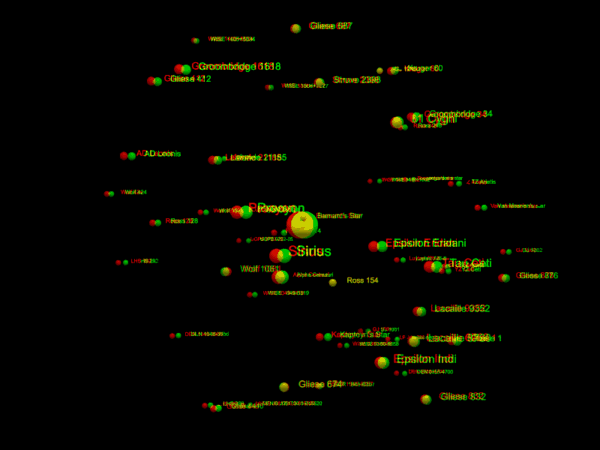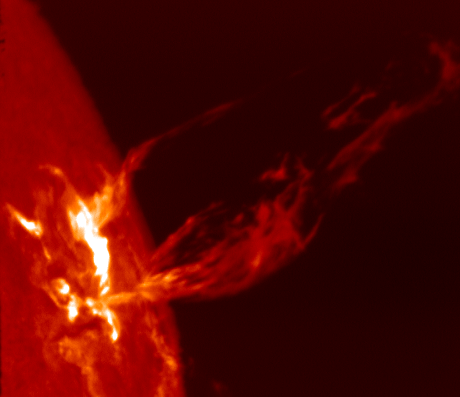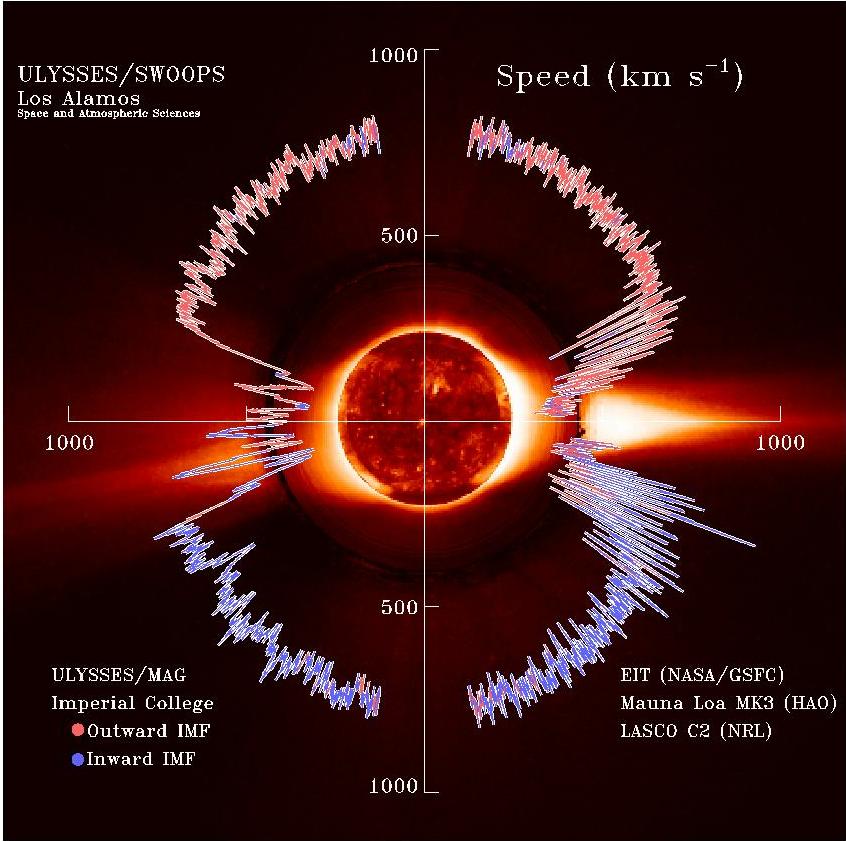|
Local Interstellar Cloud
The Local Interstellar Cloud (LIC), also known as the Local Fluff, is an interstellar cloud roughly across, through which the Solar System is moving. This feature overlaps with a region around the Sun referred to as the solar neighborhood. It is unknown whether the Sun is embedded in the Local Interstellar Cloud, or is in the region where the Local Interstellar Cloud is interacting with the neighboring G-Cloud. Like the G-Cloud and others, the LIC is part of the Very Local Interstellar Medium which begins where the heliosphere and interplanetary medium end, the furthest that probes have traveled. Structure The Solar System is located within a structure called the Local Bubble, a low-density region of the galactic interstellar medium. Within this region is the Local Interstellar Cloud (LIC), an area of slightly higher hydrogen density. It is estimated that the Solar System entered the LIC within the past 10,000 years. It is uncertain whether the Sun is still inside of the LIC ... [...More Info...] [...Related Items...] OR: [Wikipedia] [Google] [Baidu] |
Solar System
The Solar SystemCapitalization of the name varies. The International Astronomical Union, the authoritative body regarding astronomical nomenclature, specifies capitalizing the names of all individual astronomical objects but uses mixed "Solar System" and "solar system" structures in theinaming guidelines document. The name is commonly rendered in lower case ('solar system'), as, for example, in the ''Oxford English Dictionary'' an''Merriam-Webster's 11th Collegiate Dictionary''. is the gravitationally bound Planetary system, system of the Sun and the objects that orbit it. It Formation and evolution of the Solar System, formed about 4.6 billion years ago when a dense region of a molecular cloud collapsed, forming the Sun and a protoplanetary disc. The Sun is a typical star that maintains a hydrostatic equilibrium, balanced equilibrium by the thermonuclear fusion, fusion of hydrogen into helium at its stellar core, core, releasing this energy from its outer photosphere. As ... [...More Info...] [...Related Items...] OR: [Wikipedia] [Google] [Baidu] |
Iron-60
Natural iron (Fe) consists of four stable isotopes: 5.845% Fe (possibly radioactive with half-life > years), 91.754% Fe, 2.119% Fe and 0.286% Fe. There are 28 known radioisotopes and 8 nuclear isomers, the most stable of which are Fe (half-life 2.6 million years) and Fe (half-life 2.7 years). Much of the past work on measuring the isotopic composition of iron has centered on determining Fe variations due to processes accompanying nucleosynthesis (i.e., meteorite studies) and ore formation. In the last decade however, advances in mass spectrometry technology have allowed the detection and quantification of minute, naturally occurring variations in the ratios of the stable isotopes of iron. Much of this work has been driven by the Earth and planetary science communities, though applications to biological and industrial systems are beginning to emerge. List of isotopes , -id=Iron-45 , rowspan=4, 45Fe , rowspan=4 style="text-align:right" , 26 , rowspan=4 style="text-al ... [...More Info...] [...Related Items...] OR: [Wikipedia] [Google] [Baidu] |
Orion Arm
The Orion Arm, also known as the Orion–Cygnus Arm, is a minor spiral arm within the Milky Way Galaxy spanning in width and extending roughly in length. This galactic structure encompasses the Solar System, including Earth. It is sometimes referred to by alternate names such as the Local Arm or Orion Bridge, and it was previously identified as the Local Spur or the Orion Spur. It should not be confused with the outer terminus of the Norma Arm, known as the Cygnus Arm. Naming and brightness The arm is named after the Orion Constellation, one of the most prominent constellations of the Northern Hemisphere in winter (or the Southern Hemisphere in summer). Some of the brightest stars in the sky as well as other well-known celestial objects of the constellation (e.g. Betelgeuse, Rigel, the three stars of Orion's Belt, and the Orion Nebula) are found within it, as shown on Orion Arm's interactive map. Location The Orion arm is located between the Carina–Sagittarius Arm, ... [...More Info...] [...Related Items...] OR: [Wikipedia] [Google] [Baidu] |
List Of Nearby Stellar Associations And Moving Groups
file:GCNS Poster Stellar Densities top image.png, 350px, Star density maps of the Gaia Catalogue of Nearby Stars.The Sun is located at the centre of both maps. The regions with higher density of stars are shown; these correspond with known star clusters (Hyades and Coma Berenices) and moving groups. This is a list of nearby stellar associations and moving groups. A stellar association is a very loose star cluster, looser than an open cluster. A Stellar kinematics#Moving groups, moving group is the remnant of such a stellar association. Members of stellar associations and moving groups share similar kinematic properties, as well as similar ages and chemical composition. ''The list (below) is sorted by the distance to the Solar System.'' See also * List of stellar streams * List of open clusters * List of nearest stars References {{Portal bar, Astronomy, Stars, Outer space Stellar associations A stellar association is a very loose star cluster, looser than both o ... [...More Info...] [...Related Items...] OR: [Wikipedia] [Google] [Baidu] |
List Of Nearest Stars And Brown Dwarfs
This list covers all known stars, white dwarfs, brown dwarfs, and sub-brown dwarfs within of the Sun. So far, 131 such objects have been found. Only List of nearest bright stars, 22 are bright enough to be visible without a telescope, for which the star's visible light needs to reach or exceed the dimmest brightness visible to the naked eye from Earth, which is typically around 6.5 apparent magnitude. The known 131 objects are bound in 94 stellar systems. Of those, 103 are main sequence stars: 80 red dwarfs and 23 "typical" stars having greater mass. Additionally, astronomers have found 6 white dwarfs (stars that have exhausted all fusible hydrogen), 21 brown dwarfs, as well as 1 sub-brown dwarf, WISE 0855−0714 (possibly a rogue planet). The closest system is Alpha Centauri, with Proxima Centauri as the closest star in that system, at 4.2465 light-years from Earth. The brightest, most massive and most luminous object among those 131 is Sirius A, which is also the brightest s ... [...More Info...] [...Related Items...] OR: [Wikipedia] [Google] [Baidu] |
Gould Belt
The Gould Belt is a local ring of stars in the Milky Way, tilted away from the galactic plane by about 16–20 degrees, first reported by John Herschel and Benjamin Gould in the 19th century. It contains many O- and B-type stars, and many of the nearest star-forming regions of the local Orion Arm, to which the Sun belongs. The relative proximity of these star-forming regions spurred the Gould Belt Survey project to determine what caused them. It was long speculated that the belt was a physical structure in the galactic disk, but data from the Gaia survey indicate that several of its star-forming regions belong instead to the separate Radcliffe wave and ''Split'' linear structures in the Orion Arm, and that the circular appearance of the belt results mostly from the projection of these structures onto the celestial sphere. The belt contains bright, young stars which formed about 30 to 50 million years ago in several constellations. These lie along a great circle slig ... [...More Info...] [...Related Items...] OR: [Wikipedia] [Google] [Baidu] |
Interstellar Boundary Explorer
Interstellar Boundary Explorer (IBEX or Explorer 91 or SMEX-10) is a NASA satellite in Earth orbit that uses energetic neutral atoms (ENAs) to image the interaction region between the Solar System and Outer space, interstellar space. The mission is part of NASA's Small Explorer program and was launched with a Pegasus (rocket), Pegasus-XL launch vehicle on 19 October 2008. The mission is led by Dr. David J. McComas (IBEX principal investigator), formerly of the Southwest Research Institute (SwRI) and now with Princeton University. The Los Alamos National Laboratory and the Lockheed Martin Advanced Technology Center built the IBEX-Hi and IBEX-Lo sensors respectively. The Orbital Sciences Corporation manufactured the satellite bus and was the location for spacecraft environmental testing. The nominal mission baseline duration was two years after commissioning, and the prime ended in early 2011. The spacecraft and sensors are still healthy and the mission is continuing in its exten ... [...More Info...] [...Related Items...] OR: [Wikipedia] [Google] [Baidu] |
Stellar Magnetic Field
A stellar magnetic field is a magnetic field generated by the motion of conductive plasma inside a star. This motion is created through convection, which is a form of energy transport involving the physical movement of material. A localized magnetic field exerts a force on the plasma, effectively increasing the pressure without a comparable gain in density. As a result, the magnetized region rises relative to the remainder of the plasma, until it reaches the star's photosphere. This creates starspots on the surface, and the related phenomenon of coronal loops. Measurement A star's magnetic field can be measured using the Zeeman effect. Normally the atoms in a star's atmosphere will absorb certain frequencies of energy in the electromagnetic spectrum, producing characteristic dark absorption lines in the spectrum. However, when the atoms are within a magnetic field, these lines become split into multiple, closely spaced lines. The energy also becomes polarized with an orien ... [...More Info...] [...Related Items...] OR: [Wikipedia] [Google] [Baidu] |
Solar Wind
The solar wind is a stream of charged particles released from the Sun's outermost atmospheric layer, the Stellar corona, corona. This Plasma (physics), plasma mostly consists of electrons, protons and alpha particles with kinetic energy between . The composition of the solar wind plasma also includes a mixture of particle species found in the solar plasma: trace amounts of heavy ions and atomic nuclei of Chemical element, elements such as carbon, nitrogen, oxygen, neon, magnesium, silicon, sulfur, and iron. There are also rarer traces of some other nuclei and isotopes such as phosphorus, titanium, chromium, and nickel's isotopes 58Ni, 60Ni, and 62Ni. Superimposed with the solar-wind plasma is the interplanetary magnetic field. The solar wind varies in density, temperature and speed over time and over Solar coordinate systems#Heliographic, solar latitude and longitude. Its particles can escape the Sun's gravity because of their high energy resulting from the high temperature of t ... [...More Info...] [...Related Items...] OR: [Wikipedia] [Google] [Baidu] |
Nature (journal)
''Nature'' is a British weekly scientific journal founded and based in London, England. As a multidisciplinary publication, ''Nature'' features Peer review, peer-reviewed research from a variety of academic disciplines, mainly in science and technology. It has core editorial offices across the United States, continental Europe, and Asia under the international scientific publishing company Springer Nature. ''Nature'' was one of the world's most cited scientific journals by the Science Edition of the 2022 ''Journal Citation Reports'' (with an ascribed impact factor of 50.5), making it one of the world's most-read and most prestigious academic journals. , it claimed an online readership of about three million unique readers per month. Founded in the autumn of 1869, ''Nature'' was first circulated by Norman Lockyer and Alexander MacMillan (publisher), Alexander MacMillan as a public forum for scientific innovations. The mid-20th century facilitated an editorial expansion for the j ... [...More Info...] [...Related Items...] OR: [Wikipedia] [Google] [Baidu] |
Tesla (unit)
The tesla (symbol: T) is the unit of magnetic flux density (also called magnetic B-field strength) in the International System of Units (SI). One tesla is equal to one weber per square metre. The unit was announced during the General Conference on Weights and Measures in 1960 and is named in honour of Serbian-American electrical and mechanical engineer Nikola Tesla, upon the proposal of the Slovenian electrical engineer France Avčin. Definition A particle, carrying a charge of one coulomb (C), and moving perpendicularly through a magnetic field of one tesla, at a speed of one metre per second (m/s), experiences a force with magnitude one newton (N), according to the Lorentz force law. That is, \mathrm. As an SI derived unit, the tesla can also be expressed in terms of other units. For example, a magnetic flux of 1 weber (Wb) through a surface of one square meter is equal to a magnetic flux density of 1 tesla.''The International System of Units (SI), 8th edition' ... [...More Info...] [...Related Items...] OR: [Wikipedia] [Google] [Baidu] |
Pico-
A metric prefix is a unit prefix that precedes a basic unit of measure to indicate a multiple or submultiple of the unit. All metric prefixes used today are decadic. Each prefix has a unique symbol that is prepended to any unit symbol. The prefix '' kilo'', for example, may be added to ''gram'' to indicate ''multiplication'' by one thousand: one kilogram is equal to one thousand grams. The prefix '' milli'', likewise, may be added to ''metre'' to indicate ''division'' by one thousand; one millimetre is equal to one thousandth of a metre. Decimal multiplicative prefixes have been a feature of all forms of the metric system, with six of these dating back to the system's introduction in the 1790s. Metric prefixes have also been used with some non-metric units. The SI prefixes are metric prefixes that were standardised for use in the International System of Units (SI) by the International Bureau of Weights and Measures (BIPM) in resolutions dating from 1960 to 2022. Since 2009, the ... [...More Info...] [...Related Items...] OR: [Wikipedia] [Google] [Baidu] |






